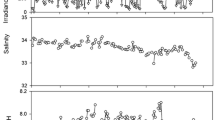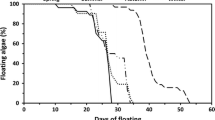Abstract
Survival of the giant kelp, Macrocystis pyrifera (Linnaeus) C. Agardh, in its natural habitat is governed by abiotic and biotic factors such as temperature, light, nutrients, current velocity, and predators. Factors affecting the survival of the alga in an aquarium setting, however, have not been investigated. The National Museum of Marine Biology and Aquarium (NMMBA), in subtropical Taiwan, is the only aquarium in the world that displays giant kelp that does not have naturally occurring specimens in nearby waters. Giant kelp displayed in aquaria often deteriorates within a 3-month period, yet the cause of this mortality is unknown. We investigated abiotic and biotic parameters affecting survival of giant kelp in aquaria over a 3-month period. The results indicated that temperature, salinity, pH, light, and nutrient concentrations did not affect giant kelp survival. However, the massive proliferation of epiphytic diatoms on kelp blades (from 7 × 102 cells cm−2 initially to 3 × 104 cells cm−2 after 1 month) was identified as being the most likely candidate affecting survival of giant kelp in an aquarium setting. Potential factors that may stimulate epiphyte proliferation include lack of epiphytic algae control via predation, high nutrient concentrations, a weak current, and a generally stable environment.






Similar content being viewed by others
References
Aumack CF, Amsler CD, McClintock JB, Baker BJ (2011a) Impacts of mesograzers on epiphyte and endophyte growth associated with chemically defended macroalgae from the Western Antarctic Peninsula: a mesocosm experiment. J Phycol 47:36–41
Aumack CF, Amsler CD, McClintock JB, Baker BJ (2011b) Changes in amphipod densities among macroalgal habitats in day versus night collections along the Western Antarctic Peninsula. Mar Biol 158:1879–1885
Bernstein BB, Jung N (1979) Selective pressures and coevolution in a kelp canopy community in southern California. Ecol Monogr 49:335–355
Bruno JF, O'Connor MI (2005) Cascading effects of predator diversity and omnivory in a marine food web. Ecol Lett 8:1048–1056
Casas-Valdez M, Serviere-Zaragoza E, Lluch-Belda D, Marcos R, Aguila-Ramírez RN (2003) Effects of climatic change on the harvest of the kelp Macrocystis pyrifera at the Mexican Pacific coast. Bull Mar Sci 73:545–556
Christie H, Fredriksen S, Rinde E (1998) Regrowth of kelp and colonization of epiphyte and fauna community after kelp trawling at the coast of Norway. Hydrobiologia 375/376:49–58
Clarke KR, Warwick RM (1994) Changes in marine communities: an approach to statistical analysis and interpretation. Plymouth Marine Laboratory, UK
Clendenning KA, Sargent MC (1971) Photosynthesis and general development in Macrocystis. Nova Hedwigia 32:169–190
Cox TE, Murray SN (2006) Feeding preferences and the relationships between food choice and assimilation efficiency in the herbivorous marine snail Lithopoma undosum (Turbinidae). Mar Biol 148:1295–1306
D'Antonio C (1985) Epiphytes on the rocky intertidal red alga Rhodomelalarix (Turner) C. Agardh: negative effects on the host and food for herbivores? J Exp Mar Biol Ecol 86:197–218
Dayton PK, Currie V, Gerrodette T, Keller BD, Rosenthal R, Ven Tresca D (1984) Patch dynamics and stability of some California kelp communities. Ecol Monogr 54:253–289
Dean TA, Jacobsen FR (1984) Growth of juvenile Macrocystis pyrifera (Laminariales) in relation to environmental factors. Mar Biol 83:301–311
Dean TA, Schroeter SC, Dixon JD (1984) Effects of grazing by two species of sea urchin (Strongylocentrotus franciscanus and Lytechinus anamesus) on recruitment and survival of two species of kelp (Macrocystis pyrifera and Pterygophora californica). Mar Biol 78:301–313
Duffy JE (1990) Amphipods on seaweeds: partners or pests. Oecologia 83:267–276
Edwards MS, Hernández-Carmona G (2005) Delayed recovery of giant kelp near its southern range limit in the North Pacific following El Niño. Mar Biol 147:273–279
Field JG, Clarke KR, Warwick RM (1982) A practical strategy for analyzing multispecies distribution patterns. Mar Ecol Prog Ser 8:37–52
Gerard VA (1984) Physiological effects of El Nino on giant kelp in southern California. Mar Biol Lett 5:317–322
Gerard VA (1986) Photosynthetic characteristics of giant kelp (Macrocystis pyrifera) determined in situ. Mar Biol 90:473–482
Gil M, Armitage AR, Fourqurean JW (2006) Nutrient impacts on epifaunal density and species composition in a subtropical seagrass bed. Hydrobiologia 569:437–447
Graham MH (1996) Effect of high irradiance on recruitment of the giant kelp Macrocystis (Phaeophyta) in shallow water. J Phycol 32:903–906
Graham MH, Vasquez JA, Buschmann AH (2007) Global ecology of the giant kelp Macrocystis: from ecotypes to ecosystems. Oceanog Mar Biol 45:39–88
Hansen AT, Hondzo M, Hurd CL (2011) Photosynthetic oxygen flux by Macrocystis pyrifera: a mass transfer model with experimental validation. Mar Ecol Prog Ser 434:45–55
Harrold C, Pearse JS (1987) The ecological role of echinoderms in kelp forests. Echinoderm Stud 2:137–233
Henley WJ, Dunton KH (1997) Effects of nitrogen supply and continuous darkness on growth and photosynthesis of the arctic kelp, Laminaria solidungula. Limnol Oceanogr 42:209–216
Hepburn CD, Holborow JD, Wing SR, Frew RD, Hurd CL (2007) Exposure to waves enhances the growth rate and nitrogen status of the giant kelp Macrocystis pyrifera. Mar Ecol Prog Ser 339:99–108
Hernandez UA, Beltrones DAS (2008) Cambios en la estructura de la asociacion de diatomeas epifitas de Macrocystis pyrifera (L.). Acta Bot Mex 82:43–66
Hernández-Carmona G, Robledo D, Serviere-Zaragoza E (2001) Effect of nutrient availability on Macrocystis pyrifera recruitment and survival near its southern limit off Baja California. Bot Mar 44:221–229
Howard RK (1982) Impact of feeding activities of epibenthic amphipods on surface-fouling of eelgrass leaves. Aquat Bot 14:91–97
Hsieh WC, Lee HJ, Tew KS, Lin C, Fan KS, Meng PJ (2010) Estimating nutrient budgets in a coastal lagoon. Chinese Sci Bull 55:484–492
Hurd CL, Harrison PJ, Druehl LD (1996) Effect of seawater velocity on inorganic nitrogen uptake by morphologically distinct forms of Macrocystis integrifolia from wave-sheltered and exposed sites. Mar Biol 126:205–214
Jackson GA (1977) Nutrients and production of giant kelp, Macrocystis pyrifera, off southern California. Limnol Oceanogr 22:979–995
Kruskal JB, Wish M (1978) Multidimensional scaling. Sage Publications, Beverly Hills
Laugaste R, Reunanen M (2005) The composition and density of epiphyton on some macrophyte species in the partly meromictic Lake Verevi. Hydrobiologia 547:137–150
Mann K (1973) Seaweeds: their productivity and strategy for growth. Science 182:975–981
Meng PJ, Lee HJ, Wang JT, Chen CC, Lin HJ, Tew KS, Hsieh WJ (2008) A long-term survey on anthropogenic impacts to the water quality of coral reefs, southern Taiwan. Environ Pollut 106:67–75
Moe RL, Silva PC (1977) Antarctic marine flora-uniquely devoid of kelp. Science 196:1206–1208
North WJ, Jackson GA, Manley SL (1986) Macrocystis and its environment, knowns and unknowns. Aquat Bot 26:9–26
Pai SC, Riley JP (1994) Determination of nitrate in the presence of nitrite in natural waters by flow injection analysis with a non-quantitative on-line cadmium redactor. Int J Environ Anal Chem 57:263–277
Pai SC, Yang CC, Riley JP (1990a) Formation kinetics of the pink azo dye in the determination of nitrite in natural waters. Anal Chim Acta 232:345–349
Pai SC, Yang CC, Riley JP (1990b) Effects of acidity and molybdate concentration on the kinetics of the formation of the phosphoantimonylmolybdenum blue complex. Anal Chim Acta 229:115–120
Pai SC, Tsau YJ, Yang TI (2001) pH and buffering capacity problems involved in the determination of ammonia in saline water using the indophenol blue spectrophotometric method. Anal Chim Acta 434:209–216
Peterson BJ, Frankovich TA, Zieman JC (2007) Response of seagrass epiphyte loading to field manipulations of fertilization, gastropod grazing and leaf turnover rates. J Exp Mar Biol Ecol 349:61–72
Poore AGB, Campbell AH, Steinberg PD (2009) Natural densities of mesograzers fail to limit growth of macroalgae or their epiphytes in a temperate algal bed. J Ecol 97:164–175
Rothäusler E, Gómez I, Hinojosa IA, Karsten U, Tala F, Thiel M (2009) Effect of temperature and grazing on growth and reproduction of floating Macrocystis spp. (Phaeophyceae) along a latitudinal gradient. J Phycol 45:547–559
Russell BD, Elsdon TE, Gillanders BM, Connell SD (2005) Nutrients increase epiphyte loads: broad scale observations and an experimental assessment. Mar Biol 147:551–558
Sala E, Graham MH (2002) Community-wide distribution of predator-prey interaction strength in kelp forests. Proc Nat Acad Sci USA 99:3678–3683
Sand-Jensen K (1977) Effect of epiphytes on eelgrass photosynthesis. Aquat Bot 3:55–63
SPSS (1997) SigmaStat statistical software. SPSS Marketing Department, Chicago
Steneck RS, Graham MH, Bourque BJ, Corbett D, Erlandson JM, Estes JA, Tegner MJ (2002) Kelp forest ecosystems: biodiversity, stability, resilience and future. Environ Conserv 29:436–459
Tegner MJ, Dayton PK (1987) El Niño effects on southern California kelp forest communities. Adv Ecol Res 17:243–279
Tegner MJ, Dayton PK (1991) Sea urchins, El Niños, and long term stability of southern California kelp forest communities. Mar Ecol Prog Ser 77:49–63
Tew KS, Conroy JD, Culver DA (2006) Effects of lowered inorganic phosphorus fertilization rates on pond production of percid fingerlings. Aquaculture 255:436–446
Zimmerman RC, Kremer JN (1984) Episodic nutrient supply to a kelp forest ecosystem in southern California. J Mar Res 42:591–604
Zimmerman RC, Kremer JN (1986) In situ growth and chemical composition of the giant kelp, Macrocystis pyrifera: response to temporal changes in ambient nutrient availability. Mar Ecol Prog Ser 27:277–285
Zimmerman RC, Robertson DL (1985) Effects of El Niño on local hydrography and growth of the giant kelp, Macrocystis pyrifera, at Santa Catalina Island, California. Limnol Oceanogr 30:1298–1302
Acknowledgments
We thank Dr. D. Glover and Ms. C. Doyle for their valuable comments on the manuscript. This work was supported by intramural funding from the National Museum of Marine Biology and Aquarium to KS Tew (981003043).
Author information
Authors and Affiliations
Corresponding author
Rights and permissions
About this article
Cite this article
Tew, K.S., Meng, PJ. & Leu, MY. Factors correlating with deterioration of giant kelp Macrocystis pyrifera (Laminariales, Heterokontophyta) in an aquarium setting. J Appl Phycol 24, 1269–1277 (2012). https://doi.org/10.1007/s10811-011-9775-z
Received:
Revised:
Accepted:
Published:
Issue Date:
DOI: https://doi.org/10.1007/s10811-011-9775-z




